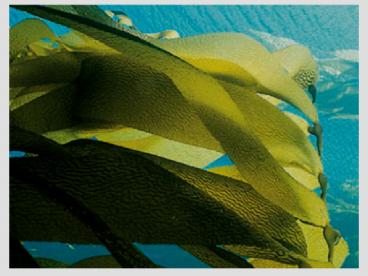Lecture 7 Outline (Ch. 10) PowerPoint PPT Presentation
1 / 34
Title: Lecture 7 Outline (Ch. 10)
1
(No Transcript)
2
Lecture 7 Outline (Ch. 10)
- Photosynthesis overview
- A. Purpose
- B. Location
- The light vs. the dark reaction
- Chloroplasts pigments
- A. Light absorption
- B. Types
- Light reactions
- A. Photosystems
- B. Photophosphorylation
- V. The light independent reaction (dark
reaction) - A. Carbon fixation
- B. Reduction
- C. Regeneration
- VI. Alternative plants
- VII. Lecture Concepts
3
Photosynthesis - overview
4
Photosynthesis - overview
Overall purpose
photosynthesis light ?chemical energy
complements respiration
- light reaction solar energy in
- dark reaction energy to organics
5
Cellular Respiration vs. Photosynthesis
6
Photosynthesis chloroplast recap
Outer membrane Inner membrane Thylakoid membrane
Intermembrane space Stroma Thylakoid space
Own DNA Own ribosomes
7
Photosynthesis - overview
Photosynthesis -
1. light rxn store energy split water photo
NADPH ATP
2. dark rxn fix CO2 make sugars synthesis
Calvin cycle
8
Redox Reactions
Equation for photosynthesis
9
Photosynthesis - overview
light reactions
dark reactions
thylakoid membrane
stroma
thylakoid space
10
Photosynthesis light absorption
visible light 380 to 750 nm
chloroplast pigments abs blue-violet red
- transmit and reflect green
11
Photosynthesis light absorption
pigments
chlorophyll a
-energy-absorbing ring
-hydrocarbon tail
accessory pigments
- chlorophyll b
- carotenoids
- photoprotective
12
Photosynthesis light absorption
chlorophyll a abs blue-violet, red 400 -
500, 650
chlorophyll b carotenoids abs broadly
blue-violet mid-400s
more wavelengths used for photosynthesis more
light energy absorbed
13
Photosynthesis light absorption
Pigments have two states ground excited
chlorophyll abs light
e- excited
more energy
energy transferred
14
Photosynthesis light absorption
Pigments are held by proteins in the thylakoid
membranes
light harvesting complex
energy absorbed from light - to pigments
to reaction center
- two special chlorophyll a
- proteins
- 1 electron acceptor
light harvesting complex reaction center
photosystem (PS)
15
Photosynthesis energy transfer
Photosystem I (PS I) PS II
Difference light wavelength, proteins, ?
where e- from
16
Photosynthesis energy transfer
PSII absorbs 680 nm,
splits water, powerful ETC, ATP made
PS I absorbs 700 nm, (less energy)
e- from PSII, short ETC, NADPH made
17
Photosynthesis energy transfer
e- in PS II, from split H20
? NADPH
18
Photosynthesis chemiosmosis
How is ATP produced?
Chemiosmosis
e- down ETC, H to thylakoid space
H conc. gradient
H down gradient, ATP synthase
photophosphorylation
19
Light reaction - summary
inputs light energy, H2O
PS II, ETC, PS I, ETC
outputs ATP NADPH O2 (waste)
20
Self-Check
Step of Photosynthesis Location IN chloroplast Inputs Outputs ATP produced (dont need ) e- carriers loaded
Light reaction overall
PSII
PSI
Dark reaction overall
Know figure 10.13, 10.16, 10.17
21
(No Transcript)
22
Light Reaction Review
23
Light reaction review
outputs ATP NADPH O2
inputs Energy (light) H2O
24
Dark reaction (Light-independent Reaction)
Dark reaction Calvin cycle
regenerative
anabolic
CO2 in, sugar out
during daylight
25
Carbon fixation
3 stages of Calvin-cycle
1 carbon fixation
CO2 link to 5-C
5-C ribulose bisphosphate (RuBP) - enzyme
Rubisco
abundant
6-C unstable split ? 2(3-C)
26
Reduction
3 stages of Calvin-cycle
2 reduction
3-C reduced
e- from NADPH
reduced 3-C G3P
27
Regeneration of C-acceptor
3 stages of Calvin-cycle
3 regenerate C-acceptor
still 5 G3P ? 3 RuBP
multiple steps
uses ATP
every 3 cycles 1 G3P made 3 RuBP regenerated
C3 plants CO2 fixed into 3-C
28
Alternate methods of C fixation
29
Alternate methods of C fixation
CO2 in ? stomata
open, lose water
hot, dry open stomata less lowers water
loss, lowers CO2
O2 fixed photorespiration inefficient
fix CO2 into 4-C molecules
30
Photosynthesis summary
light reaction Light energy H2O
O2, NADPH, ATP
Thylakoids
light-independent CO2, NADPH, ATP
G3P (sugar), RuBP
Stroma
31
Photosynthesis summary
Where do photosynthetic products go?
32
Self-Check
Step of Photosynthesis Location IN chloroplast Inputs Outputs ATP produced (dont need ) e- carriers loaded
Light reaction overall
PSII
PSI
Dark reaction overall
Know figure 10.13, 10.16, 10.17
33
(No Transcript)
34
Lecture 7 Concepts
- Describe in words the purpose of photosynthesis
- Write the equation for photosynthesis
- List the steps of photosynthesis and where they
occur - Understand why plants (chloroplasts) appear green
- For the light reaction, describe inputs and
outputs include what the splitting of water
means and the step this is used - Describe the parts of the photosystems and how
PSII and PSI are different - Compare photophosphorylation and oxidative
phosphorylation - Be able to label on the equation for
photosynthesis what is meant by splitting water
and where in the chloroplast this takes place - For the Calvin cycle (light independent reaction)
describe inputs and outputs include where in
the chloroplast this happens - Write out a list of new terminology and provide
descriptions

